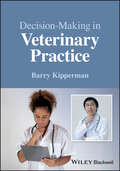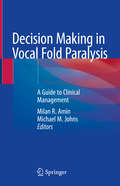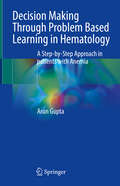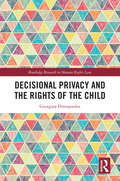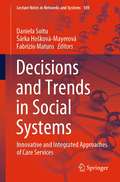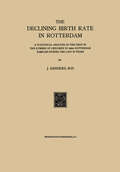- Table View
- List View
Decision Making in Medicine E-Book: An Algorithmic Approach
by Stuart B. Mushlin Harry L. Greene IIThis popular reference facilitates diagnostic and therapeutic decision making for a wide range of common and often complex problems faced in outpatient and inpatient medicine. Comprehensive algorithmic decision trees guide you through more than 250 disorders organized by sign, symptom, problem, or laboratory abnormality. The brief text accompanying each algorithm explains the key steps of the decision making process, giving you the clear, clinical guidelines you need to successfully manage even your toughest cases.An algorithmic format makes it easy to apply the practical, decision-making approaches used by seasoned clinicians in daily practice. Comprehensive coverage of general and internal medicine helps you successfully diagnose and manage a full range of diseases and disorders related to women’s health, emergency medicine, urology, behavioral medicine, pharmacology, and much more. A Table of Contents arranged by organ system helps you to quickly and easily zero in on the information you need. More than a dozen new topics focus on the key diseases and disorders encountered in daily practice. Fully updated decision trees guide you through the latest diagnostic and management guidelines.
Decision-Making in Midwifery Practice E-Book
by Maureen D. Raynor Jayne E. Marshall Amanda SullivanThe book looks at a broad perspective of decision making and each chapter focuses on a specific aspect related to making crucial decisions. Following an initial introduction the book explores the concept of autonomy and the many factors that influence autonomous practise. The role of knowledge in decision making, using evidence to inform decisions, as well as different approaches to decision making are also examined - including the traditional or rational approach, decision analysis and the development of professional judgement. Dilemmas arise when decisions are made and therefore ethical decision making is an important component of this book. Management decisions may be different from those related to giving specific care to women, hence one chapter focuses on making management decisions. Emphasis is also placed on the role of the midwife in helping women make their own decisions, the role of reflection in enhancing the decisions midwives make and the support midwives can receive from their Supervisor of Midwives. Flowcharts explain and facilitate the decision-making process.A very practical approach to decision-making in midwifery, with contributions from midwives who have considerable experience in this areaProvides guidelines on how to achieve successful autonomous midwifery practice, enabling theory to be effectively applied to practiceIncludes coverage of management roles and decision-making as well as clinical scenarios, offering frameworks and flowcharts to guide the inexperiencedSuggests different approaches to making difficult decisions
Decision Making in Radiation Oncology: Volume 1 (Medical Radiology)
by Jiade J. Lu Luther W. BradyDecision Making in Radiation Oncology is a reference book designed to enable radiation oncologists, including those in training, to make diagnostic and treatment decisions effectively and efficiently. The design is based on the belief that “a picture is worth a thousand words.” Knowledge is conveyed through an illustrative approach using algorithms, schemas, graphics, and tables. Detailed guidelines are provided for multidisciplinary cancer management and radiation therapy techniques. In addition to the attention-riveting algorithms for diagnosis and treatment, strategies for the management of disease at individual stages are detailed for all the commonly diagnosed malignancies. Clinical trials that have yielded “gold standard” treatment and their results are documented in the schemas. Moreover, radiation techniques, including treatment planning and delivery, are presented in an illustrative way. This groundbreaking publication is an essential tool for physicians in their daily clinical practice.
Decision Making in Radiation Oncology: Volume 2 (Medical Radiology)
by Jiade J. Lu Luther W. BradyDecision Making in Radiation Oncology is a reference book designed to enable radiation oncologists, including those in training, to make diagnostic and treatment decisions effectively and efficiently. The design is based on the belief that “a picture is worth a thousand words.” Knowledge is conveyed through an illustrative approach using algorithms, schemas, graphics, and tables. Detailed guidelines are provided for multidisciplinary cancer management and radiation therapy techniques. In addition to the attention-riveting algorithms for diagnosis and treatment, strategies for the management of disease at individual stages are detailed for all the commonly diagnosed malignancies. Clinical trials that have yielded “gold standard” treatment and their results are documented in the schemas. Moreover, radiation techniques, including treatment planning and delivery, are presented in an illustrative way. This groundbreaking publication is an essential tool for physicians in their daily clinical practice.
Decision-Making in Reconstructive Surgery: Upper Extremity
by G. Germann R. Sherman L.S. LevinA new approach to methodical and strategic thinking about tissue reconstruction. All the decision-making processes are broken down into algorithms based on the authors' clinical experience and the current literature. The atlas section describes the 25 most frequently used flaps, and shows them in standardised graphic form along with many practical tips and tricks. New here is the inclusion in the illustrations of practical suggestions for the surgeon, as well as rehabilitation protocols for post-operative management. In short, a maximum of information with a minimum of text.
Decision Making in Small Animal Oncology
by David J. Argyle Malcolm J. Brearley Michelle M. TurekDecision Making in Small Animal Oncology is a practical manual for the increasing number of veterinarians called upon to treat patients with cancer. This case-based quick reference leads practitioners through diagnosis, treatment, and management decisions, offering reliable guidance for more effective management of cancer care. With easy-to-follow algorithms to assist the reader through the critical thinking process, Decision Making in Small Animal Oncology answers the questions most commonly asked in daily practice to provide the cancer knowledge practitioners and students need in general practice.
Decision-Making in Veterinary Practice
by Barry KippermanDecision-Making in Veterinary Practice The first-ever guide to rational decision-making in veterinary practice The practice of veterinary medicine entails crucial decisions about patient care on a daily basis. Whether to admit patients displaying symptoms, whether to pursue diagnoses or prioritize therapeutic trials, whether to advise overnight stays after routine surgery, whether to refer patients; the answers to questions like these can significantly influence patient outcomes and standards of care. However, veterinary clinicians are seldom trained to analyze their patterns of decision-making, relying instead on the existing culture of a practice to dictate their behaviors. This can lead to irrational decisions, institutional inertia, reluctance to comply with evidence-based medicine, and failure to optimize patient outcomes. Decision-Making in Veterinary Practice provides the first-ever dedicated guide to rational principles for decision-making in veterinary practice. Rooted in the study of normative ethics, it seeks to pose important questions and develop processes by which they can be answered. The book promises to transform the clinical performance of clinicians and practices that utilize it. Decision-Making in Veterinary Practice readers will also find: Discussions of key issues based on extensive clinical experience and evidence Detailed discussion of important decision determinants like time of day, patient weight, criteria for stopping treatment, and more Essential insights on clinical decision-making and clinical reasoning Decision-Making in Veterinary Practice is ideal for all veterinary practitioners, veterinary students, and clinical skills instructors.
Decision-Making in Veterinary Practice
by Barry KippermanDecision-Making in Veterinary Practice The first-ever guide to rational decision-making in veterinary practice The practice of veterinary medicine entails crucial decisions about patient care on a daily basis. Whether to admit patients displaying symptoms, whether to pursue diagnoses or prioritize therapeutic trials, whether to advise overnight stays after routine surgery, whether to refer patients; the answers to questions like these can significantly influence patient outcomes and standards of care. However, veterinary clinicians are seldom trained to analyze their patterns of decision-making, relying instead on the existing culture of a practice to dictate their behaviors. This can lead to irrational decisions, institutional inertia, reluctance to comply with evidence-based medicine, and failure to optimize patient outcomes. Decision-Making in Veterinary Practice provides the first-ever dedicated guide to rational principles for decision-making in veterinary practice. Rooted in the study of normative ethics, it seeks to pose important questions and develop processes by which they can be answered. The book promises to transform the clinical performance of clinicians and practices that utilize it. Decision-Making in Veterinary Practice readers will also find: Discussions of key issues based on extensive clinical experience and evidence Detailed discussion of important decision determinants like time of day, patient weight, criteria for stopping treatment, and more Essential insights on clinical decision-making and clinical reasoning Decision-Making in Veterinary Practice is ideal for all veterinary practitioners, veterinary students, and clinical skills instructors.
Decision Making in Vocal Fold Paralysis: A Guide to Clinical Management
by Milan R. Amin Michael M. JohnsThis guide brings thought leaders and master clinicians together to share their wisdom and expertise regarding clinical decisions surrounding unilateral and bilateral vocal fold paralysis. Designed as a what- to-do and why as opposed to a how-to guide, the authors detail the reasoning process from work up, through intervention, to post-treatment decision making. The text is organized around decision points in the management of vocal fold paralysis such as decisions in regard to timing, intervention, implants, reinnervation, drugs, voice therapy, and post-operative care. Individual chapters focus on specific steps in the process of evaluation and treatment, explore the decisions that can and should be made, and provide answers and direction for the reader. Authors explain the issues around the decision point and use their considerable experience to offer their opinion and as well as the thought process behind it. Decision Making in Vocal Fold Paralysis will be a useful guide for practitioners that deal with vocal fold paralysis, including otolaryngologists, general surgeons, neurologists, speech language pathologists, primary care physicians, and oncologists.
Decision Making Through Problem Based Learning in Hematology: A Step-by-Step Approach in patients with Anemia
by Arun GuptaIn this era of teaching through problem-based learning, this unique book guides approaching patients with anemia through a step-by-step analysis of test results. It explains the rationale for requesting appropriate tests and analyzing them systematically and correlates each answer to the disease-based entity on the latest evidence. The target audience is undergraduate medical students during hematopathology training and the introductory phase in clinical Medicine and Hematology, postgraduate residents in Hematology and Medicine, and undergraduate and postgraduate Allied Health students. It provides a quick reference source for practitioners and teachers in medical and paramedical institutions. Question-answer format for quick review before exams. Hundreds of visual illustrations with microscopic images and tables.Quick reference for students in wards and clinics.
Decision Modelling for Health Economic Evaluation (Handbooks in Health Economic Evaluation)
by Andrew Briggs Mark Sculpher Karl ClaxtonIn financially constrained health systems across the world, increasing emphasis is being placed on the ability to demonstrate that health care interventions are not only effective, but also cost-effective. This book deals with decision modelling techniques that can be used to estimate the value for money of various interventions including medical devices, surgical procedures, diagnostic technologies, and pharmaceuticals. Particular emphasis is placed on the importance of the appropriate representation of uncertainty in the evaluative process and the implication this uncertainty has for decision making and the need for future research. This highly practical guide takes the reader through the key principles and approaches of modelling techniques. It begins with the basics of constructing different forms of the model, the population of the model with input parameter estimates, analysis of the results, and progression to the holistic view of models as a valuable tool for informing future research exercises. Case studies and exercises are supported with online templates and solutions. This book will help analysts understand the contribution of decision-analytic modelling to the evaluation of health care programmes. ABOUT THE SERIES: Economic evaluation of health interventions is a growing specialist field, and this series of practical handbooks will tackle, in-depth, topics superficially addressed in more general health economics books. Each volume will include illustrative material, case histories and worked examples to encourage the reader to apply the methods discussed, with supporting material provided online. This series is aimed at health economists in academia, the pharmaceutical industry and the health sector, those on advanced health economics courses, and health researchers in associated fields.
Decision Neuroscience: An Integrative Perspective
by Jean-Claude Dreher Léon TremblayDecision Neuroscience addresses fundamental questions about how the brain makes perceptual, value-based, and more complex decisions in non-social and social contexts. This book presents compelling neuroimaging, electrophysiological, lesional, and neurocomputational models in combination with hormonal and genetic approaches, which have led to a clearer understanding of the neural mechanisms behind how the brain makes decisions. The five parts of the book address distinct but inter-related topics and are designed to serve both as classroom introductions to major subareas in decision neuroscience and as advanced syntheses of all that has been accomplished in the last decade. Part I is devoted to anatomical, neurophysiological, pharmacological, and optogenetics animal studies on reinforcement-guided decision making, such as the representation of instructions, expectations, and outcomes; the updating of action values; and the evaluation process guiding choices between prospective rewards. Part II covers the topic of the neural representations of motivation, perceptual decision making, and value-based decision making in humans, combining neurcomputational models and brain imaging studies. Part III focuses on the rapidly developing field of social decision neuroscience, integrating recent mechanistic understanding of social decisions in both non-human primates and humans. Part IV covers clinical aspects involving disorders of decision making that link together basic research areas including systems, cognitive, and clinical neuroscience; this part examines dysfunctions of decision making in neurological and psychiatric disorders, such as Parkinson’s disease, schizophrenia, behavioral addictions, and focal brain lesions. Part V focuses on the roles of various hormones (cortisol, oxytocin, ghrelin/leptine) and genes that underlie inter-individual differences observed with stress, food choices, and social decision-making processes. The volume is essential reading for anyone interested in decision making neuroscience. With contributions that are forward-looking assessments of the current and future issues faced by researchers, Decision Neuroscience is essential reading for anyone interested in decision-making neuroscience. Provides comprehensive coverage of approaches to studying individual and social decision neuroscience, including primate neurophysiology, brain imaging in healthy humans and in various disorders, and genetic and hormonal influences on decision makingCovers multiple levels of analysis, from molecular mechanisms to neural-systems dynamics and computational models of how we make choicesDiscusses clinical implications of process dysfunctions, including schizophrenia, Parkinson’s disease, eating disorders, drug addiction, and pathological gamblingFeatures chapters from top international researchers in the field and full-color presentation throughout with numerous illustrations to highlight key concepts
Decision Science for Future Earth: Theory and Practice
by Tetsukazu YaharaThis open access book provides a theoretical framework and case studies on decision science for regional sustainability by integrating the natural and social sciences. The cases discussed include solution-oriented transdisciplinary studies on the environment, disasters, health, governance and human cooperation. Based on these case studies and comprehensive reviews of relevant works, including lessons learned from past failures for predictable surprises and successes in adaptive co-management, the book provides the reader with new perspectives on how we can co-design collaborative projects with various conflicts of interest and how we can transform our society for a sustainable future. The book makes a valuable contribution to the global research initiative Future Earth, promoting transdisciplinary studies to bridge the gap between science and society in knowledge generation processes and supporting efforts to achieve the UN’s Sustainable Development Goals (SDGs). Compared to other publications on transdisciplinary studies, this book is unique in that evolutionary biology is used as an integrator for various areas related to human decision-making, and approaches social changes as processes of adaptive learning and evolution. Given its scope, the book is highly recommended to all readers seeking an integrated overview of human decision-making in the context of social transformation.
Decision Support System for Diagnosis and Treatment of Hearing Disorders: The Case of Tinnitus (Studies in Computational Intelligence #685)
by Katarzyna A. Tarnowska Zbigniew W. Ras Pawel J. JastreboffThe book presents a knowledge discovery based approach to build a recommender system supporting a physician in treating tinnitus patients with the highly successful method called Tinnitus Retraining Therapy.It describes experiments on extracting novel knowledge from the historical dataset of patients treated by Dr. P. Jastreboff so that to better understand factors behind therapy's effectiveness and better personalize treatments for different profiles of patients.The book is a response for a growing demand of an advanced data analytics in the healthcare industry in order to provide better care with the data driven decision-making solutions.The potential economic benefits of applying computerized clinical decision support systems include not only improved efficiency in health care delivery (by reducing costs, improving quality of care and patient safety), but also enhancement in treatment's standardization, objectivity and availability in places of scarce expert's knowledge on this difficult to treat hearing disorder.Furthermore, described approach could be used in assessment of the clinical effectiveness of evidence-based intervention of various proposed treatments for tinnitus.
Decision Support System for the Location of Healthcare Facilities: SitHealth Evaluation Tool (SpringerBriefs in Applied Sciences and Technology)
by Marta Dell'Ovo Alessandra Oppio Stefano CapolongoThe book examines an integrated approach for addressing decisions about the location of healthcare facilities. Supported by Geographic Information Systems (GIS) and Multi-Criteria Decision Analysis (MCDA), the approach provides comprehensive information on territory, taking into account the spatial dimensions. Due to the multiple criteria involved, site selection for urban facilities is a crucial topic in planning decision processes, especially for healthcare facilities. Healthcare provision policies generally fail to address the distribution of facilities within cities, entrusting decisions to various stakeholders. Moreover current evaluation tools focus on the intrinsic performances of healthcare structures, disregarding the extrinsic characteristics, namely those related to the location. Starting with a cross-disciplinary literature review, the book describes a multi-methodological approach for decision-making regarding the location of healthcare facilities, and presents an innovative evaluation tool that simultaneously considers functional, locational, environmental and economic issues, providing a comprehensive overview of the areas under investigation.
Decision Support Systems in Critical Care (Computers and Medicine)
by M. Michael Shabot Reed M. GardnerModern critical care is characterized by the collection of large volumes of data and the making of urgent patient care decisions. The two do not necessarily go together easily. For many years the hope has been that ICU data management systems could play a meaningful role in ICU decision support. These hopes now have a basis in fact, and this book details the history, methodology, current status, and future prospects for critical care decision support systems. By focusing on real and operational systems, the book demonstrates the importance of integrating data from diverse clinical data sources; the keys to implementing clinically usable systems; the pitfalls to avoid in implementation; and the development of effective evaluation methods.
Decision Tools for Radiation Oncology: Prognosis, Treatment Response and Toxicity (Medical Radiology)
by Carsten Nieder Laurie E. GasparA look at the recent oncology literature or a search of the common databases reveals a steadily increasing number of nomograms and other prognostic models. These models may predict the risk of relapse, lymphatic spread of a given malignancy, toxicity, survival, etc. Pathology information, gene signatures, and clinical data may all be used to compute the models. This trend reflects increasingly individualized treatment concepts, the need for approaches that achieve a favorable balance between effectiveness and side-effects, and the goal of optimal resource utilization reflecting prognostic knowledge. In order to avoid misuse, it is important to understand the limits and caveats of prognostic and predictive models. This book provides a comprehensive overview of such decision tools for radiation oncology, stratified by disease site, which will enable readers to make informed choices in daily clinical practice and to critically follow the future development of new tools in the field.>
Decisional Privacy and the Rights of the Child (Routledge Research in Human Rights Law)
by Georgina DimopoulosDecisional privacy gives individuals the freedom to act and make decisions about how they live their lives, without unjustifiable interference from other individuals or the state. This book advances a theory of a child’s right to decisional privacy. It draws on the framework of the United Nations Convention on the Rights of the Child and extends the work of respected children’s rights scholars to address a significant gap in understanding the interconnections between privacy, family law and children’s rights. It contextualises the theory through a case study: judicial proceedings concerning medical treatment for children experiencing gender dysphoria. This work argues that recognising a substantive right to decisional privacy for children requires procedural rights that facilitate children’s meaningful participation in decision-making about their best interests. It also argues that, as courts have increasingly encroached upon decision-making regarding children’s medical treatment, they have denied the decisional privacy rights of transgender and gender diverse children. This book will benefit researchers, students, judicial officers and practitioners in various jurisdictions worldwide grappling with the tensions between children’s rights, parental responsibilities and state duties in relation to children’s best interests, and with the challenge of better enabling and listening to children’s voices in decision-making processes.
Decisional Privacy and the Rights of the Child (Routledge Research in Human Rights Law)
by Georgina DimopoulosDecisional privacy gives individuals the freedom to act and make decisions about how they live their lives, without unjustifiable interference from other individuals or the state. This book advances a theory of a child’s right to decisional privacy. It draws on the framework of the United Nations Convention on the Rights of the Child and extends the work of respected children’s rights scholars to address a significant gap in understanding the interconnections between privacy, family law and children’s rights. It contextualises the theory through a case study: judicial proceedings concerning medical treatment for children experiencing gender dysphoria. This work argues that recognising a substantive right to decisional privacy for children requires procedural rights that facilitate children’s meaningful participation in decision-making about their best interests. It also argues that, as courts have increasingly encroached upon decision-making regarding children’s medical treatment, they have denied the decisional privacy rights of transgender and gender diverse children. This book will benefit researchers, students, judicial officers and practitioners in various jurisdictions worldwide grappling with the tensions between children’s rights, parental responsibilities and state duties in relation to children’s best interests, and with the challenge of better enabling and listening to children’s voices in decision-making processes.
Decisions and Trends in Social Systems: Innovative and Integrated Approaches of Care Services (Lecture Notes in Networks and Systems #189)
by Daniela Soitu Šárka Hošková-Mayerová Fabrizio MaturoThis book presents a systemic perspective on the broadly perceived problem of social care, meant in terms of a network engaging balanced resources and actors to assure the functionality, in an integrative approach. The approach involves individual, institutional and organizational structures, at the micro, mezzo- and macro-levels, in their interrelations, with proper contexts for understandings, interpretations and actions by stakeholders. The papers presented suggest ways of changes, involving even participant actors as changing agents, taking into account evolving behaviors and human relations, policies and inter-institutional frameworks, from many points of view. In the first part, various aspects, notably economic and emotional, of innovative and integrated approaches to long-term care are dealt with. Different aspects are considered exemplified by legal, educational, economic, environmental, cultural and those related to the perception of aging, labor market for the elderly, perceived quality of life, etc. The planning and management of social services are discussed in terms of a functional, and effective and efficient system, with the identification and analysis of actors and processes, and transformation policies. This is done at the local, regional and global levels.
Deckungsbeitragsrechnung für Krankenhäuser: Analyse – Verfahren – Praxisbeispiele (Controlling im Krankenhaus)
by Winfried ZappDie Deckungsbeitragsrechnung ist eine Teilkostenrechnung und kann unterschiedlich gestaltet und ausgerichtet sein, wobei sich unter anderem kostenträger- und kostenstellenorientierte Verfahren unterscheiden lassen. In diesem Buch werden beide Verfahren exemplarisch entwickelt und mit Zahlen und Daten jeweils eines ausgewählten Beispiel-Krankenhauses anwendungsorientiert dargestellt. Die kostenträgerorientierte Variante wird aus den Vorgaben des Kalkulationshandbuches konzipiert, so dass eine schnelle Herleitung mit den Kalkulationsdaten möglich ist. Die kostenstellenorientierte Deckungsbeitragsrechnung wird ebenfalls in einem Modellhaus anwendungsorientiert hergeleitet und mit den verschiedenen Analysemöglichkeiten dargestellt. In einem dritten Beispiel wird herausgearbeitet, wie ein Controlling aus einer reinen Vollkostenrechnung Analysedaten bereitstellen kann. Somit werden unterschiedliche Verfahren differenziert vorgestellt, sodass deutlich wird, welche Arbeitsschritte notwendig sind, welche Analyse-Möglichkeiten sich daraus ergeben, um darauf aufbauend ein anwendungsorientiertes Controlling voranzutreiben und zu gestalten. Dieses Buch richtet sich an Führungskräfte in Krankenhäusern und Gesundheitseinrichtungen sowie an Studierende aus dem Bereich Gesundheitsmanagement, Controlling und Rechnungswesen.
The Decline of Therapeutic Bloodletting and the Collapse of Traditional Medicine
by K. Codell CarterOver the course of a single generation, without significant discussion or debate, a key practice of traditional medicine was almost completely abandoned in mid-nineteenth-century Europe. K. Codell Carter's book describes how and why bloodletting was abandoned, noting that it was part of a process in which innovation was required so that modern scientific medicine could begin. This book is a masterful study on the collapse of a traditional medical practice. Bloodletting had been a prominent medical therapy in early nineteenth-century Europe and can be traced back to Greek and Roman physicians. The Hippocratic corpus contains several discussions of bloodletting. Galen, the most famous physician in classical antiquity, wrote tracts explaining and defending the practice. It was employed in ancient Egypt and is the most commonly mentioned therapy in the Babylonian Talmud. Indeed, it was practiced in virtually every part of the ancient world. Even though the practice abruptly ceased, there was little argument against it or reason to believe it ineffective. In reality, bloodletting actually worked. However, the rise of modern medicine required not just a change in how disease and causation were conceived, but also a change in the role of medicine in society. It has been claimed that the collapse of traditional medicine was a precondition for the rise of modern medicine, but there has been little support for this assertion before now. Carter provides this missing support. The result is a fascinating study in the history of medical practice and social expectations.
The Decline of Therapeutic Bloodletting and the Collapse of Traditional Medicine
by K. Codell CarterOver the course of a single generation, without significant discussion or debate, a key practice of traditional medicine was almost completely abandoned in mid-nineteenth-century Europe. K. Codell Carter's book describes how and why bloodletting was abandoned, noting that it was part of a process in which innovation was required so that modern scientific medicine could begin. This book is a masterful study on the collapse of a traditional medical practice. Bloodletting had been a prominent medical therapy in early nineteenth-century Europe and can be traced back to Greek and Roman physicians. The Hippocratic corpus contains several discussions of bloodletting. Galen, the most famous physician in classical antiquity, wrote tracts explaining and defending the practice. It was employed in ancient Egypt and is the most commonly mentioned therapy in the Babylonian Talmud. Indeed, it was practiced in virtually every part of the ancient world. Even though the practice abruptly ceased, there was little argument against it or reason to believe it ineffective. In reality, bloodletting actually worked. However, the rise of modern medicine required not just a change in how disease and causation were conceived, but also a change in the role of medicine in society. It has been claimed that the collapse of traditional medicine was a precondition for the rise of modern medicine, but there has been little support for this assertion before now. Carter provides this missing support. The result is a fascinating study in the history of medical practice and social expectations.
The Declining Birth Rate in Rotterdam: A Statistical Analysis of the Drop in the Number of Children in 24644 Rotterdam Families During the Last 50 Years
by J. SandersDecoding Cardiac Electrophysiology: Understanding the Techniques and Defining the Jargon
by Afzal SohaibThis book provides a concise overview of cardiac electrophysiology for cardiologists who are not electrophysiologists and for allied cardiovascular professionals, cardiology registrars and fellows who are new to the field. It familiarises them with the main procedures performed in the electrophysiology laboratory. Emphasis is placed on helping the reader develop a core understanding of how data is collected and interpreted in the electrophysiology laboratory, and how this is used to guide ablation for the commonest arrhythmias including AV nodal re-entry tachycardia, accessory pathways, atrial fibrillation and ventricular arrhythmias. Decoding Cardiac Electrophysiology: Understanding the Techniques and Defining the Jargon will translate some of the technical terminology and data frequently used by electrophysiologists into terms and concepts familiar to the wider cardiovascular community. This includes the interpretation of electrograms and 3D electro-anatomical maps of common arrhythmias. Accordingly, it offers a valuable resource for all non-electrophysiologists seeking a guide to the topic and for electrophysiology trainees establishing their core knowledge and skills in the field. The aim is that this should be the first book anyone new to the field should choose to read.






